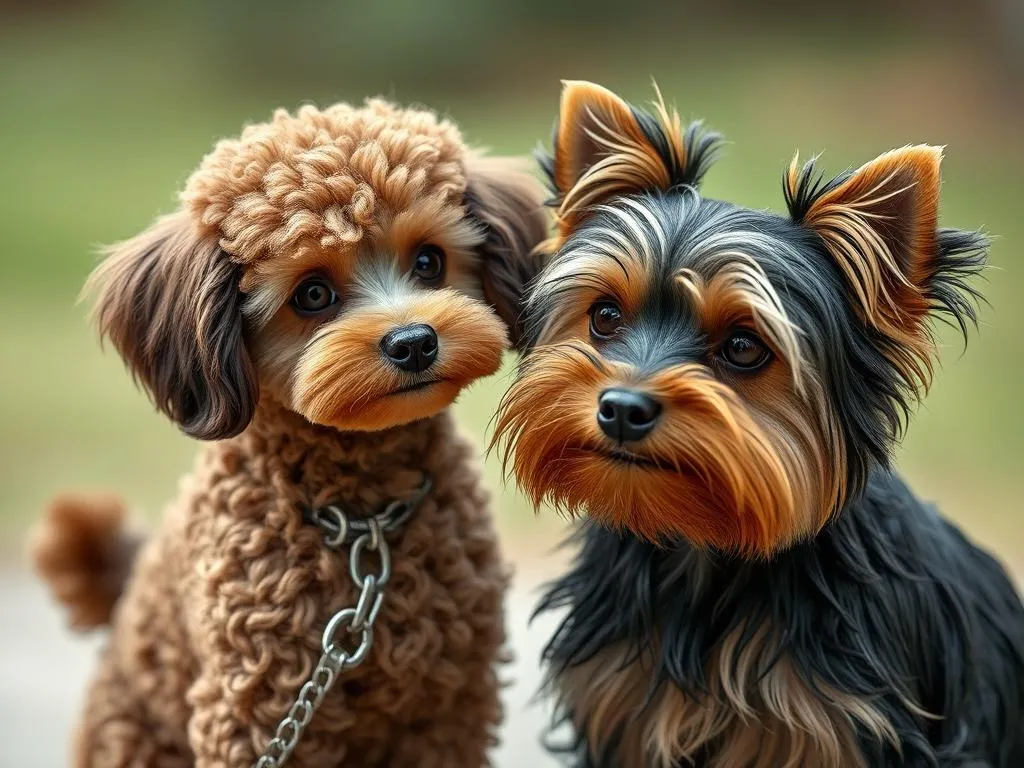
Introduction
Small dog breeds have captured the hearts of pet lovers around the world, thanks to their charming personalities and compact sizes. Among the most popular options are the Toy Poodle and the Yorkshire Terrier, often affectionately called Yorkies. These breeds not only bring joy and companionship but also have unique characteristics that set them apart. Understanding the differences and similarities between these two beloved breeds can help prospective dog owners make informed decisions. In this article, we will delve into various aspects of both breeds, providing a thorough comparison to assist you in choosing the right companion for your lifestyle.
Overview of Toy Poodle
History and Origin
The Toy Poodle is a miniature version of the standard Poodle, which has a rich history dating back to the 15th century. Originally bred in Germany as a water retriever, the Poodle was later refined in France, where it became a symbol of nobility and sophistication. The Toy variety emerged in the early 20th century, catering to those who desired a smaller companion without sacrificing the Poodle’s intelligence and trainability.
Physical Characteristics
Toy Poodles are known for their petite stature. They typically stand about 10 inches tall and weigh between 4 to 6 pounds. Their coat is curly and hypoallergenic, making them a popular choice for allergy sufferers. Color variations include black, white, apricot, and gray. Regular grooming is essential to maintain their coat’s quality and prevent matting.
Temperament and Personality
The temperament of a Toy Poodle is one of its most appealing traits. They are known for being intelligent, alert, and eager to please. These dogs are social and enjoy interacting with humans and other pets. Their playful nature makes them suitable for families, although they can sometimes be reserved around strangers.
Health Considerations
Toy Poodles generally have a lifespan of 12 to 15 years. However, they are prone to certain health issues, including dental problems, hip dysplasia, and progressive retinal atrophy. Regular vet check-ups, a balanced diet, and proper dental care are crucial for their well-being.
Overview of Yorkshire Terrier (Yorkie)
History and Origin
The Yorkshire Terrier, or Yorkie, has its origins in England during the 19th century. Bred for catching rats in clothing mills, the Yorkie quickly gained popularity as a companion animal due to its feisty personality and elegant appearance. The breed was recognized by the American Kennel Club in 1885 and has since become a favorite among small dog enthusiasts.
Physical Characteristics
Yorkies are compact and sturdy dogs, standing about 7 to 8 inches tall and weighing between 4 to 7 pounds. They are easily recognizable due to their long, silky fur, which is typically blue and tan. Grooming is a significant commitment for Yorkies, as their hair requires regular brushing to prevent tangles and mats.
Temperament and Personality
Yorkies are known for their bold and spirited personalities. They are affectionate and form strong bonds with their owners. Their confident nature often leads them to act like much larger dogs, making them good watchdogs. However, they may not always be the best choice for families with very young children due to their small size and delicate nature.
Health Considerations
The average lifespan of a Yorkie ranges from 12 to 15 years. They are generally healthy but can suffer from health issues such as dental problems, patellar luxation, and hypoglycemia. Regular veterinary care, a proper diet, and dental hygiene are essential to maintaining their health.
Comparing Toy Poodle and Yorkie
Size and Weight
When comparing the Toy Poodle and Yorkie, both breeds are similar in size, but there are slight differences in their weight and height. While Toy Poodles typically weigh between 4 to 6 pounds, Yorkies can range from 4 to 7 pounds. Both breeds are small enough to thrive in apartments and small homes, making them ideal for city living.
Coat and Grooming Needs
Grooming is a vital aspect of both breeds, but their coat types differ significantly. Toy Poodles have a curly, hypoallergenic coat that requires grooming every 4 to 6 weeks. In contrast, Yorkies have long, silky hair that needs to be brushed daily to prevent knots. While both breeds require regular grooming, the effort and tools needed may vary based on the coat type.
Temperament
Both the Toy Poodle and the Yorkie possess friendly and affectionate temperaments. However, Toy Poodles tend to be more trainable due to their eagerness to please. Yorkies, while also intelligent, can be more independent and sometimes stubborn. This difference can affect training experiences, especially for first-time dog owners.
Training and Intelligence
In terms of trainability, Toy Poodles are often considered one of the most intelligent breeds. They excel in obedience training and can learn commands quickly. Yorkies are also intelligent but may require more patience during training sessions due to their spirited nature. Both breeds benefit from early socialization and consistent training.
Exercise and Activity Levels
Both the Toy Poodle and Yorkie are energetic breeds, but the Toy Poodle generally has higher exercise needs. These dogs thrive on daily walks, playtime, and mental stimulation. Yorkies also enjoy play but may be more suited to short bursts of activity. Understanding these differences can help owners provide the right amount of exercise for their furry friends.
Choosing the Right Breed for You
Lifestyle Considerations
When deciding between a Toy Poodle vs Yorkie, consider your lifestyle and living situation. Toy Poodles may require more exercise and mental engagement, while Yorkies can adapt well to a more sedentary lifestyle. Assess your daily routine to determine which breed aligns better with your activity levels.
Family Compatibility
Both breeds can adapt to family life, but their temperament may influence their suitability. Toy Poodles are generally better with children due to their calm demeanor, while Yorkies may be more suitable for families with older children who can understand their delicate nature. Consider your family’s dynamics and who will be interacting with the dog most frequently.
Budget and Maintenance
The cost of owning a dog extends beyond the initial purchase price. Toy Poodles may incur higher grooming costs due to their curly coats, while Yorkies also require regular grooming but may need fewer visits to the groomer. Additionally, consider food costs, veterinary expenses, and supplies when making your decision.
Conclusion
In summary, both the Toy Poodle and the Yorkshire Terrier are delightful companions, each with unique traits that cater to different lifestyles. The Toy Poodle is known for its intelligence, trainability, and energetic nature, while the Yorkie boasts a bold personality and affectionate demeanor. Ultimately, the choice between these two breeds should be based on personal preferences, family dynamics, and lifestyle compatibility. Thorough research and consideration will guide you in making the best decision for your future furry friend.
FAQs
What is the average lifespan of a Toy Poodle vs Yorkie?
Both breeds generally have a lifespan of around 12 to 15 years, but individual health can vary based on genetics and care.
Are Toy Poodles hypoallergenic?
Yes, Toy Poodles are considered hypoallergenic due to their curly, non-shedding coat, making them suitable for allergy sufferers.
How do the grooming needs compare?
Toy Poodles require grooming every 4 to 6 weeks, while Yorkies need daily brushing and regular grooming to maintain their long coats.
Which breed is better for first-time dog owners?
Toy Poodles may be more suitable for first-time dog owners due to their trainable nature and adaptability, although both breeds can thrive with proper care and attention.









